|
|
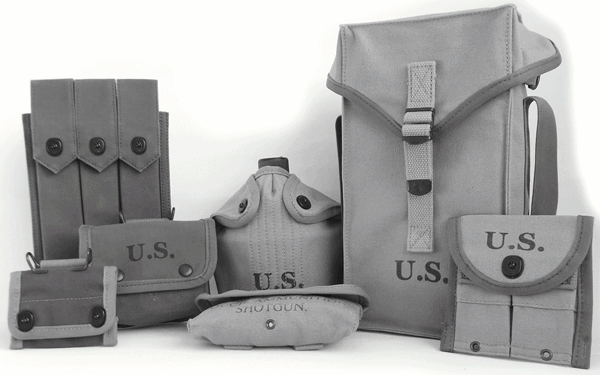
The Colours Of War (Webbing Equipment & Field Gear Colours 1908-1956)
As the 19th century drew to a close, many nations replaced the traditional materials used by there soldiers for carry cartridges, rations and other necessities of war, with the more modern materials that had been made possible due to the industrial revolution, the result of which was a decline in the use of leather in the favour of much stronger and far more durable woven fabrics which were far more suited to the modern battle field, what follows is many of a technical nature if you which to read about the historical aspects of such equipment then there are many very good examples available.
The Mills Revolution
Both Britain and America were originally supplied with webbing equipment woven and manufactured by the same company known as the Mills Woven Cartridge Belt Company in the United States of America and in Britain as the Mills Equipment Company (MECo) a Subsidiary setup in the United Kingdom by Brigadier General Anson Mills in responses to the War offices interest in adopting such webbing for the British and Commonwealth forces. Mills also developed Duck Cotton Canvas at around about the sometime a product that would become the foundation for most U.S Army Field Gear for the next eight years.
The Origins Of Khaki
The word like many is not of English origin and again is just one of many which have become part of the English language as a result of the British Occupation of the Indian sub-continent, the term which appears in both the Hindustani, and Urdu tongue and ruff translation it means Dusty or Dust Ashes etc. So the term came to mean a muddy brown shade of dye used originally for uniforms. The actual dye used to produce this colour was made form a verity of natural materials including Tea, a Native Indian Beetle, and even Mulberry juice. By WWII a Dark Green Dye extract was developed which was made from Stinging nettles this particular shade of “khaki” was used to dye Wool Serge, which was then turned into Army Battledress Jackets and Trousers. This random and rather hap-harassed way of defining a colour carried on until the mid 1990’s when British equipment suppliers and Manufactures finally got together and made a defined list of shades of Khaki which were given specific colour codes such as Khaki 91, Khaki 95 and Special khaki etc, these all range in shade and are used for specific Military applications such as parachute harnesses’ and land Rover Webbing straps etc.
Khaki the Colour (WWI,WWII -1945)
British Khaki
British Webbing Equipment made from 1908 until the 1970’s was manufactured in a colour a kin the original Khaki shade which was derived from that which was first used in India in the latter part of the 19th century. This colour is a brownish shade which sometimes has a slight greenish hue, this colour was used for most webbing whether it was made by MECo, MW &S Ltd etc. British equipment on the whole is a pretty uniform in colour and shade, and items of WWI manufacture look a very similar colour to those made for ceremonial and parade duties by MECo in the 1970’s .
Canadian Khaki.
Being a large commonwealth nation the Canadian government took the step of adopting the British pattern 1908 Webbing equipment and also the subsequent Pattern 1937 system developed just before the Second World War. Again the webbing colour for Canadian manufactured items is fairly constant in shade, regardless of the actually factory or company that produced the items, but is more of a Yellow Ochre colour with an almost orange hue to the material in certain light which gives Canadian items a distinctive look.
American Khaki
True American Khaki is also a shade of brown, and borders on beige in some cases, most U.S. Army field gear manufactured between 1915 -1942 was a sand tan shade of brown known as O.D#9 or Khaki, around about 1942 for some reason now lost to history the U.S. Army quartermasters change the colour specifications for all subsequent web gear production, this had the effect of changing the colour from a sandy tan brown shade to a light olive green colour that is now commonly referred to as (O.D#3) or by a large number of American collectors khaki, when in fact this colour is not actually Khaki at all.
Olive Drab (#9, #3, #7)
Furthermore the Americans took the step years before the British of standising there colours for the manufacture of all Government equipment including clothing, vehicles and Field Gear. This then became part of the specification laid down to the manufacturer along with fabric weights number of stitches etc more of which I’ll talk about shortly. So American colours from the First World War onwards can be tied down to a specific colour (although shades and tone vary considerably) and I have laid out a chart below which give a ruff idea of what colours were used when, also due to the large production facilities owned by some U.S. manufacturers some equipment can have its own shade due to the supplier, this is partially true of Boyt who made everything from 782 Gear for the USMC to leather holsters and M1928 haversacks their gear tends to follow the colours trends of the war but be there own shade of Olive Drab #9, #3, #7 etc.
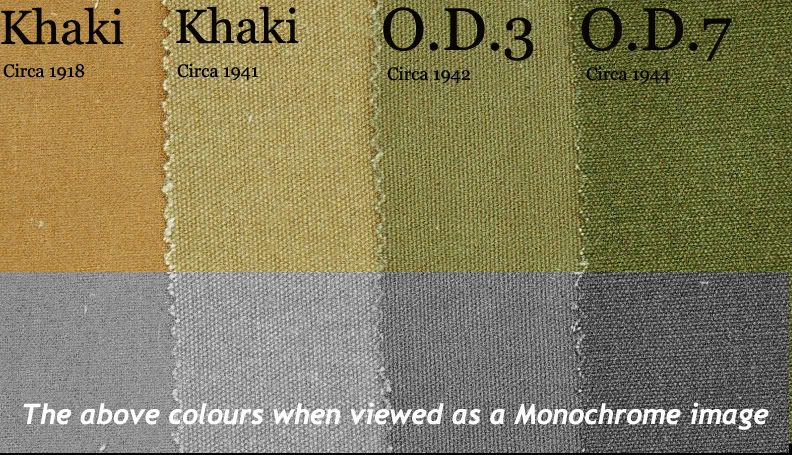
Colour Swatches showing various shades and approximate dates of production.
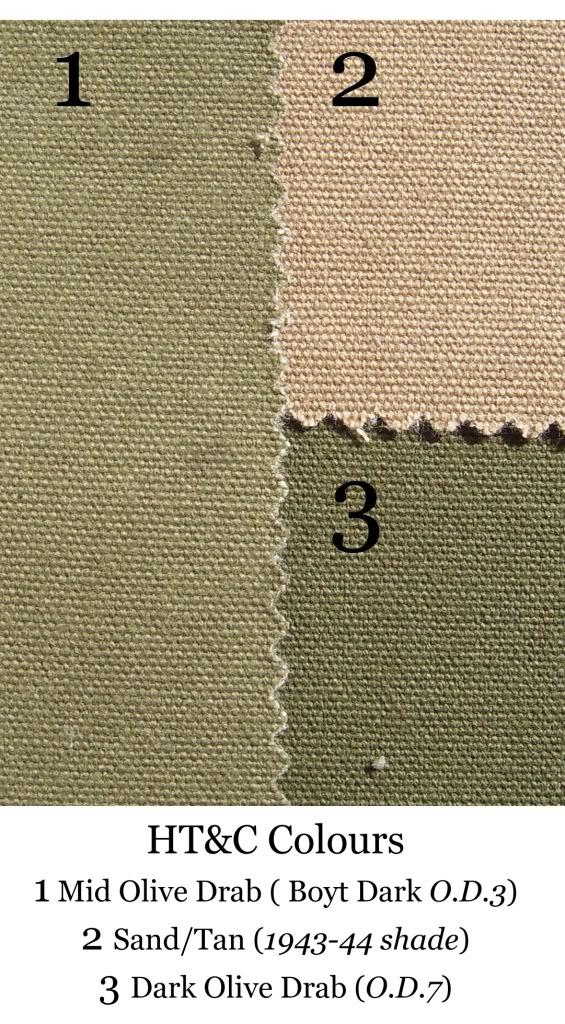
-
Olive Drab # O.D.3 (Mid-Olive Green)
-
Olive Drab # O.D.9 (Sand/Tan Khaki)
-
Olive Drab # O.D.7 (Dark Olive Green)
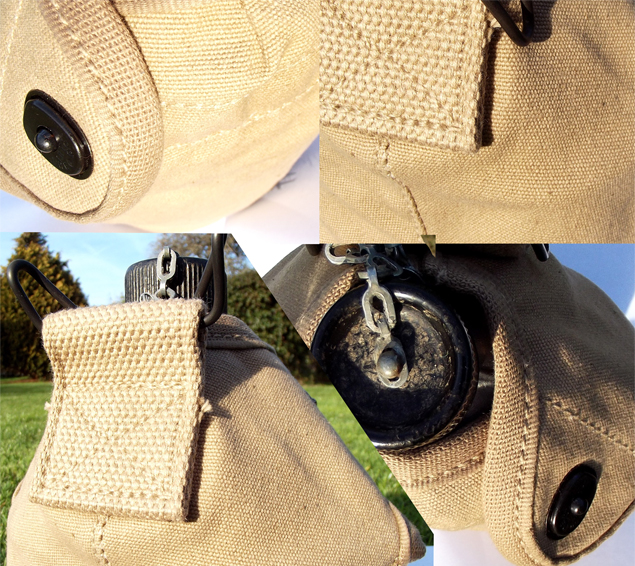
(My O.D#9 (Khaki) Seen in good daylight no digtial editing of the colour)
Transitional Production (Multicoloured Warfare)
About the end of 1942 some manufacturers started to make items out of more than one colour, these items have become known as transitional models. Transitional items were a result of wartime necessities to use up existing stocks of fabrics and webbing even though a new colour specifications had been ordered, the result was the subsequent batches of materials would dyed to the new colour of the time and then be used in conjunction with existing stocks of an old batch and thus colour. Between 1940-1945 the U.S Government change the colour specification four times from Tan/Sand Brown, to Light Olive Green, back to a Sand/Tan Hint of Green shade before finally settling on a Dark Olive Green which would remain untouched until the late 1950‘s, again as a footnote years of collecting have told me that don’t take anything for granted I’ve seen late coloured items in O.D.#7 made in 1942 and even O.D.#9 items made in 1945!
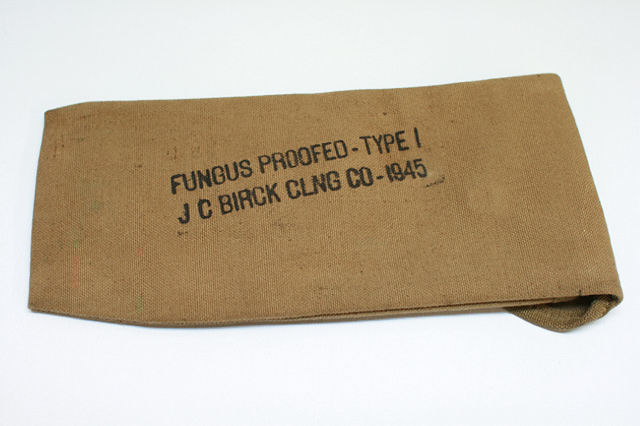 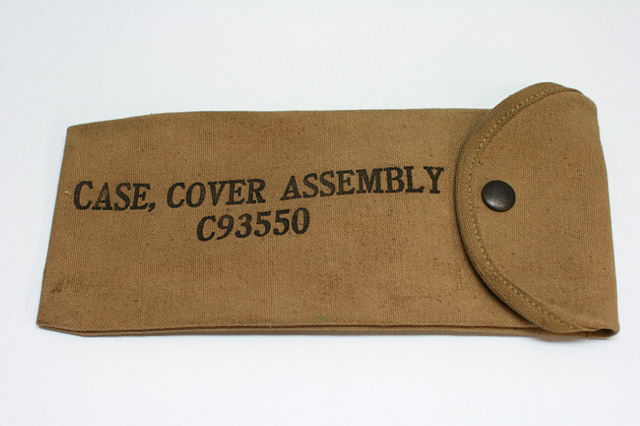
An All Khaki Canvas Case 1945 Dated!
Technical Specifications (WWII Web Gear)
A Stitch In Time.
I read much both on the internet and books regards stitching, and sewing machines, most of it spouted by people who don’t have the first clue of what there talking about. Much has been said by the “WWII Stitch Counters Sewing Circle” as I call them who seam to spend many hours going through their web gear collections checking that every item has the right number of stitches oh and there in an imperial length of measurement. This is all total dribble, most WWII machines were designs which date back to the 1890’s with some models from the 1920‘s and 1930‘s, most models manufactured in that period do not have a fixed stitch length or stitch length adjustment, if you’ve only ever looked at you aunts old Singer then you’ll not really know, most industrials were setup by the operator using a spare piece of fabric or a sheet of paper, the machine is run and then the holes are counted, then if the machine require adjusting then the knob or thumb screw etc, would be adjusted accordingly until the correct number of stitches per inch was achieved. Sewing Machines can also lose there stitch length if say for example sewing very thick layers of fabric under the foot with a stitch length which has been set as mentioned above, again is a common misconception among collectors and this problem is caused by the condition of the feed or the amount of pressure on the foot, or even the skill of the operator.
Lock Those Chains
Again there has been much debate of late regards chain stitch machines over lock stitch especially when talking about twin or double needle models, in most cases all web gear was made using a lock sewing machine, this has a bobbin and the back stitch looks exactly the same as the top stitch, the reason is this type of stitch is very strong and even if the thread breaks the item will maintain its strength for a long period afterwards without a total loss or failure. Chain stitch however is totally different as this loops the back stitch over to pick up with the top stitch the effect is similar to a knitted loop or chain or for that matter the hook and loop threads that make up stockings and hosiery, and as a result if the thread breaks under load then the seam of the web gear would burst open causing an instant failure. So there was very little use of chain stitch due to these draw backs, in some cases the use of a twin needle cahin stitch machine, was down to the manufacturer as opposed to the original specification laid down by the government.
U.S. Quatermaster Stitching Guidelines

Threads (Time To Spin A Yarn)
Synthetic materials were still a burgeoning industry in the late 1930’s as a result there was little use of these modern synthetic fabrics on the battle field until the 1950’s. Most items except those relating to parachute harness and canopies were made from one hundred percent cotton this included the yarns for the Canvas and webbing and also the threads used to stitch the items together with, as the result the threads used both in Britain and the United states were somewhat thicker than there modern equivalent this was down to strength as modern polyester and nylon threads have a much higher strain weight for there thickness than there wartime cotton counterparts, this also means that the correct weight cotton thread requires a heavier Sewing machine and a larger gauge needle. Approximate weights were 18 Ply 3 Cord* or 18 Ply 4 Cord* in ether Cotton or Linen (*Quoted in English Linen Ticket Number), today in the metric world we live in that’s about Metric Ticket #12.
Canvas Verses Webbing (The Big Change)
By the time of the combat equipment review which started in the late 1920’s the U.S. Army started to change its equipment policy slightly with items being made form a mixture of canvas and webbing components as opposed to the WWI practice of manufacturing most items out of pre-woven widths of the webbing. The advantages were mainly cost and ease of manufacturer with a steady decline in the use of webbing as the war went on, which in turn freed up the shuttle looms to concentrate on certain production. As more and more items were being replaced with a canvas alterative, it meant that other companies more a kin to making clothing, bedding and mattress could without much difficulty switch to war work more or less over night. The result of this changes meant that webbing usage reduced and canvas thickness increase from the WWI-Early WWII weight of 10-12oz’s per square yard to the Mid-late WWII 14-16 oz’s per square yard.
Strap Webbing (Type III Class III, Etc)
Around about the mid 1920’s the Army and other groups within the Government standardised a new strap webbing specification. This change the type of webbing used on all items form a Type III Class I to the familiar Type III Class III seen on all WWII production web gear, the main differences is that webbing has a duel layer edge which extra yarn in the side walls of the strap, this increase the overall strength of the webbing and gives the straps a much higher maximum loading before the webbing would fail. Again as with the flat panel webbing used for the manufacture of earlier web gear all U.S. government webbing was woven on a Dobby shuttle loom this in itself making the strap webbing much stronger as the side walls are drawn tight into the centre of the weft as the strap is constructed. The big problem how is when there is a World War on, this takes time which is why I sure that this was yet another reason why more items were being produced in canvas by 1945 then there had been back in 1940. As a footnote to this MECo and others British company’s carried on using the old Class III Type I style webbing for all British production until there demise in the 1970's.
Buckles Buttons & DOT’s (Hardware from Brass to Steel)
America started WWII very much as it had end WWI all hardware was Brass and cast Bronze blackened with the ether an Ebonol or Acid chemical finish. As the war progressed certain materials came into sort supply with aluminium and brass being among them, as a result many of the fitting that had formally been made of brass were now instead produced in mild steel with ether a Black Oxide or Parkerized or even die-cast out of a zinc based pot metal which was then painted with a semi-gloss black enamel paint. Many of the fitting themselves had been in production before WWI many of them being produced by the Judd Brothers company Anchor Brand Hardware, again some new items were introduced such as ladder lock buckles and suspender slides but in the main the hardware was basically the same as all WWI gear. As to fasteners the types used were those produced by United Carr these included Baby lift the DOT’s, Lift the DOT’s, Baby Durable DOT’s and finally Durable DOT’s, these were supplied in a number of finishes depending on there end use, again Nickel plated, Black Ebonol, Plain brass, and Parkerized steel.
HT&C (How We Make Our Repro's)
If you have taken the time to read any of the above then I'm sure you'll understand that we have spent a great amount of time on research as a result I’ve tried my best were possible to keep to the original specification laid down during WWII, our specs are;
Canvas.
Specially dyed 100 percent cotton 14oz to 16oz per square yard (Depending on the colour and supplier)
Webbing.
100 percent cotton Shuttle loom production all specially woven and colour matched to the canvas. The Strap webbing and Binding excides the original spec’s with the binding being a slightly heavier in weight than the original.
Threads
To 18 ply 4 cord weight for most web gear, some riggers items are made with a lighter thread. Specially sourced Cotton mixed thread (100 percent cotton thread is no longer available in this weight and certainly not in my colours)
Hardware
Genuine Lift the DOT’s , Anchor Brand and all other fittings from U.S suppliers no Chinese Shit here thank you.
Sewing Machines
All of 1930’s & 1940’s models most were built during the Second World War, models include correct type used by parachute riggers in Normandy on and after D-Day, also super heavy duty machines used for most of my web gear production, also we have wartime heavy duty binding machines and finally I’ve now invested in an over stitcher/over locker and a Bartack machine as used for M1 Helmet straps and some edge bound items.

Finally heres a picture of my Singer 132K6 Industrial sewing machine, the smaller sewing machine is a 1900 Singer 27K Domestic Model which belonged to my great Aunt. So next time your thinking about making a battle jerkin as your very first project, using that Old Singer you bought off eBay, just bare in mind I make my ones on the industrial machine its standing on LOL.
|
The Oxford English Dictionary Definition Of
anorak
Pronunciation: /'an?rak/
noun
1 A waterproof jacket, typically with a hood, of a kind originally used in polar regions.
2 British informal, derogatory a studious or obsessive person with unfashionable and largely solitary interests: with his thick specs, shabby shoes, and grey suit, he looks a bit of an anorak
Nigel
|
|

